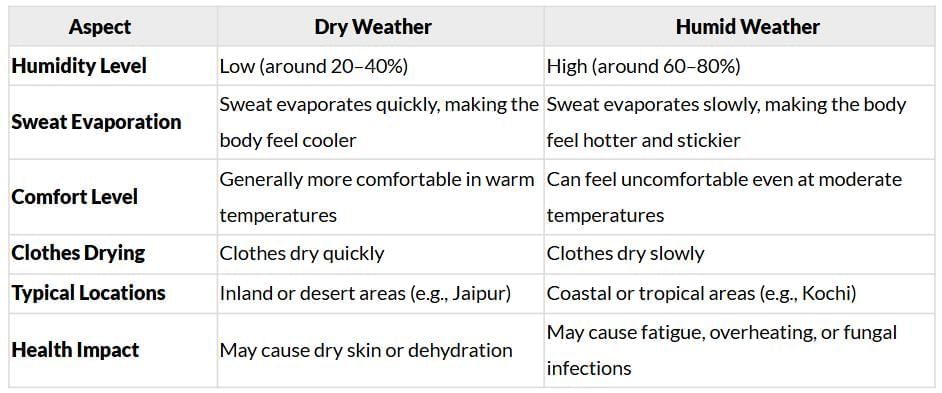Class 7 Social Science Chapter 2 Question Answers - Understanding the Weather
Short Answer Questions
Q1: Why is it important to predict weather accurately?
Ans: Accurate weather predictions help us prepare for natural events like storms, droughts, and heatwaves. They protect lives and property and help various professions plan better.
Q2: How does weather influence the daily life of people?
Ans: Weather affects the clothes we wear, the food we eat, and even the activities we do.
For example, people wear warm clothes in winter and cool clothes in summer.
 Weather and SeasonsQ3: What role do meteorologists play in predicting weather?
Weather and SeasonsQ3: What role do meteorologists play in predicting weather?
Ans: Meteorologists collect data from weather instruments and use scientific methods to forecast weather. Their predictions help in disaster preparedness and planning.
Q4: Why is the troposphere important in understanding weather?
Ans: The troposphere is where all weather changes occur, including rain, wind, and snow. It contains the air we breathe and supports life on Earth.
Q5: How do high altitudes affect atmospheric pressure and human health?
Ans: At high altitudes, air pressure is lower and oxygen levels are lower, causing breathlessness. This makes it harder for people like mountaineers or soldiers to breathe easily.
Q6: What is the use of a digital thermometer in weather measurement?
Ans: Digital thermometers give precise temperature readings and can store data. They help scientists track temperature changes accurately throughout the day.
Q7: How do changes in air pressure lead to storms or cyclones?
Ans: Low air pressure can form a depression, which leads to stormy conditions or cyclones. These systems bring strong winds and heavy rainfall.
Q8: What are some signs in nature that help predict the weather?
Ans: Animals and plants show signs like birds flying low or pine cones closing, which can indicate rain. These traditional signs are still used, especially in rural India.
Q9: What is the role of an Automated Weather Station (AWS)?
Ans: An AWS uses sensors to automatically measure weather elements like temperature, humidity, and pressure. It provides timely and accurate weather data without human involvement.
AWS at Sikkim
Q10: Why does high humidity make us feel uncomfortable?
Ans: High humidity reduces the evaporation of sweat, making us feel hotter and sweatier. It also makes clothes dry slower and causes stickiness.
Q11: How does weather forecasting help farmers?
Ans: Farmers use weather forecasts to decide when to plant or harvest crops. Knowing about rainfall or heatwaves in advance helps protect their fields and animals.
Q12: What is the meaning behind IMD’s motto, “From the sun arises rain”?
Ans: The motto “From the sun arises rain” means that the heat of the sun starts the water cycle. It explains that heat from the sun causes water to evaporate and form rain clouds. It highlights the sun’s role in driving the water cycle.
Long Answer Questions
Q1: Explain the five main elements of weather and how they affect us.
Ans: Five main elements of weather and how they affect us are as follows:
- Temperature tells us how hot or cold the air is.
- Precipitation includes rain or snow.
- Atmospheric pressure influences storms and calm weather.
- Wind helps with pollination and affects rainfall and soil.
- Humidity determines how dry or sticky the air feels.
Q2: How is temperature measured, and what types of thermometers are used?
Ans: Temperature is measured using thermometers.
- Clinical thermometers are used for body temperature, while laboratory thermometers measure environmental temperatures.
- Digital thermometers are modern, accurate, and can store data.
- They can also record maximum and minimum temperatures.
- Temperature is recorded in Celsius or Fahrenheit.
- Understanding temperature patterns helps in weather forecasting and health safety.
Q3: Describe how rainfall is measured using a rain gauge.
Ans: A rain gauge collects rain through a funnel into a cylinder.
- The depth of the water is then measured on a scale, usually in millimeters.
- If it snows, the snow is melted before measurement.
- This helps in calculating the total precipitation over a day or month.
- Accurate rainfall data is important for farming, water management, and flood control.
Rain Gauge
Q4: What is atmospheric pressure, and why is it important in weather studies?
Ans: Atmospheric pressure is the weight of air pressing down on Earth’s surface.
- It is measured using a barometer, typically in millibars.
- Low pressure can lead to storms and cyclones, while high pressure brings clear skies.
- Pressure also varies with height—lower at high altitudes and higher at sea level.
- Knowing pressure changes helps meteorologists predict weather conditions.
Q5: How do wind instruments help us understand weather better?
Ans: Wind direction is shown using a wind vane, while speed is measured with an anemometer.
- Wind socks are used at airports to observe wind movement.
- These tools help in studying wind behavior, which affects rainfall, seed dispersal, and flying conditions.
- Wind moves from high to low pressure areas.
- Measuring wind is important for pilots, sailors, and farmers.
Anemometer
Q6: What are the differences between dry and humid weather?
Ans: The differences between dry and humid weather are as follows:
Q7: How do weather stations function, and what instruments do they use?
Ans: Weather stations collect data on temperature, rainfall, wind, humidity, and air pressure.
- They use tools like thermometers, rain gauges, barometers, anemometers, and hygrometers.
- This information helps track and forecast weather.
- Automated Weather Stations (AWS) use sensors to record data without human effort.
- Weather stations are set up in cities, farms, and high-altitude areas for accuracy.
Q8: Why is understanding weather important for different professions and governments?
Ans: Understanding weather is important for different professions and governments is following way:
- Farmers need to know when to plant or protect crops.
- Pilots and sailors need wind and visibility updates for safety.
- Governments rely on forecasts to prepare for disasters like cyclones or floods.
- Accurate weather data helps plan relief operations and avoid loss.
- Weather understanding supports decision-making in agriculture, transport, and disaster management.
|
23 videos|204 docs|12 tests
|
FAQs on Class 7 Social Science Chapter 2 Question Answers - Understanding the Weather
| 1. What are the main factors that affect weather? |  |
| 2. How do meteorologists predict the weather? |  |
| 3. What is the difference between weather and climate? |  |
| 4. Why is understanding weather important for daily life? |  |
| 5. What are some common tools used to measure weather conditions? |  |























